8 Sand & Dunes Driving Tips to Get Ready for Beach Season
Being an off-road enthusiast means experiencing many different terrains, and there’s nothing comparable to cruising up a shoreline with the windows down and the fresh air blasting through your vehicle.
However, off-roading in the sand requires some know how; it's the only playground where, if you make the wrong move, your vehicle could roll sideways downhill like a tumbleweed, get swept away with the tide or sink in quicksand. However, the experience is sensational and totally worth the challenge.
The Silver Lake State Park is one of the few areas in the United States where drivers can still enjoy riding freely on sand dunes. It’s the only location left in Michigan, a state recognized for its beautiful, rolling dunescapes. During the annual Silver Lake Dunes Jeep Invasion, off-roaders from the area flood Mears, Michigan. This year upwards of 920 Jeeps showed up.
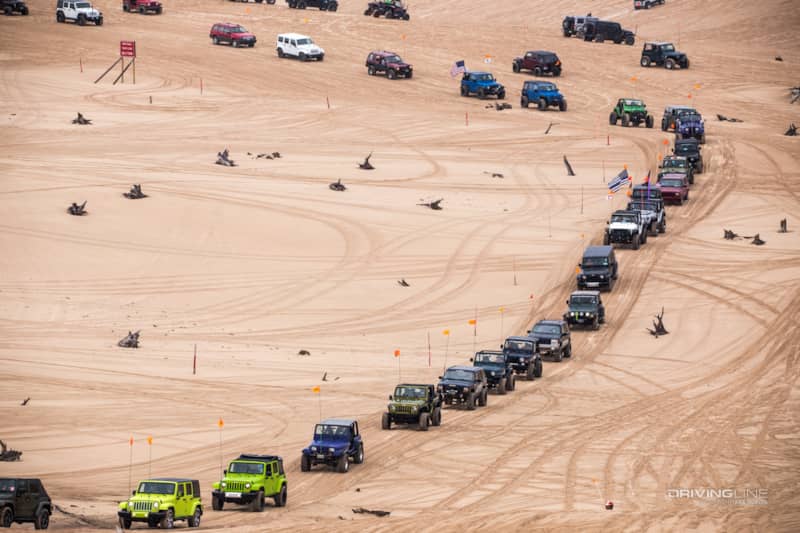
Since sand is such an ever-changing particulate force, it poses its fair share of challenges, but there are plenty of tips and tricks to keep you afloat. Here are some sand driving basics:
Start out with tires.
The most important thing, hands down, is a good set of tires. Hitting the dunes with super skinny or dangerously old, less pliable threads won’t get you far. I recently upgraded the tires on my Jeep Cherokee to a set of P285/70 R17 Nitto Ridge Grapplers to pair with my 17x8.5-inch Method Race Wheels. After just one run up a dune, I knew I had made the right choice.
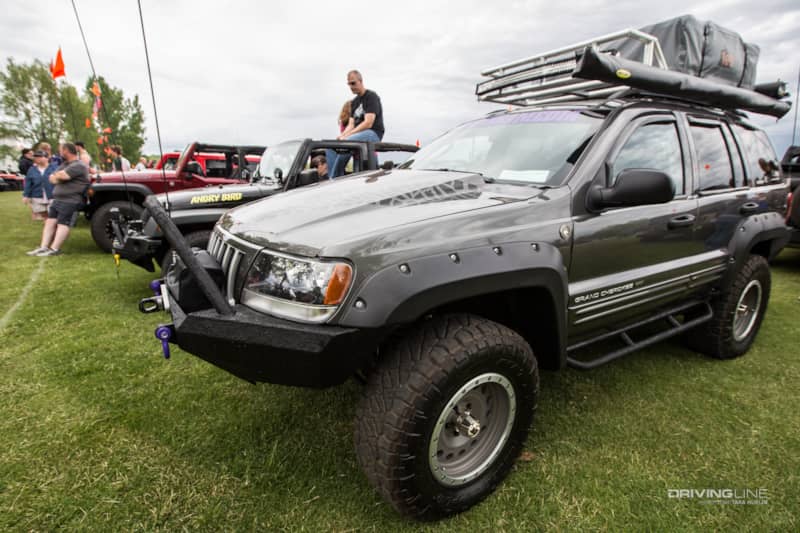
Compared to my last setup, I was able to go places that my old tires were never able to get a grip on. Best of all, this wheel/tire combo tolerates being aired down to 10 psi, which allowed my 4,500-pound expedition rig to seemingly float over unpacked sand.
Good tires, but still having trouble? Air down.
Once you reach the transition from pavement to sand, immediately let the air out of your tires. The lower the psi, the larger the tire's footprint–allowing the vehicle to, in a sense, "float" over the sand instead of digging itself into trenches. Enthusiasts drop tire pressure anywhere between 5-20 psi depending on the sand's softness and the wheel/tire combination being used. Beadlocks would be needed for the bottom end of that scale.
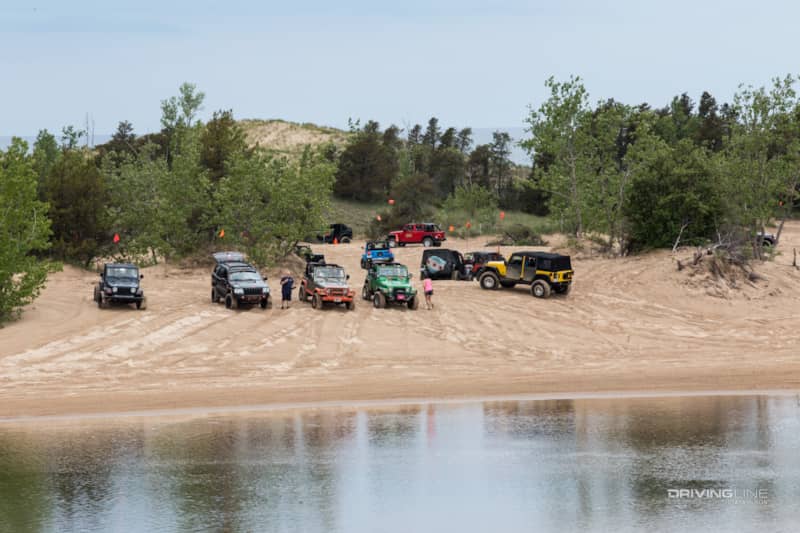
On the flip side, as soon as you get back to solid ground, the first thing to do is to re-inflate. Without it, your ability to turn and brake will be severely lacking on pavement. If you don't have an air compressor to use upon leaving the sandbox, keep that in consideration when airing down; just a couple of miles to the next gas station could peel a tire off a rim.
Know your limits.
If a front-wheel-drive car is all you have, you should probably stay home. Rear-drive cars do better, but nothing beats 4WD. A proper part-time 4WD system with a low range and a locked center differential will surf through almost any beach. Even a full-time AWD road car can do a limited amount of sand cruising, but you won’t have the ground clearance needed for anything too heavy, plus you run a risk of overheating the transmission. The bottom line is, be aware of your vehicle’s limitations, and be honest with yourself regarding your own limits as a driver.
Safety starts with awareness.
Keep your eyes out for other drivers, especially the less-visible ATVs and dirt bikes. Most recreation areas will require for you to mount a 10-foot trail flag to your front bumper. Even if it isn’t required, it’s still recommended.
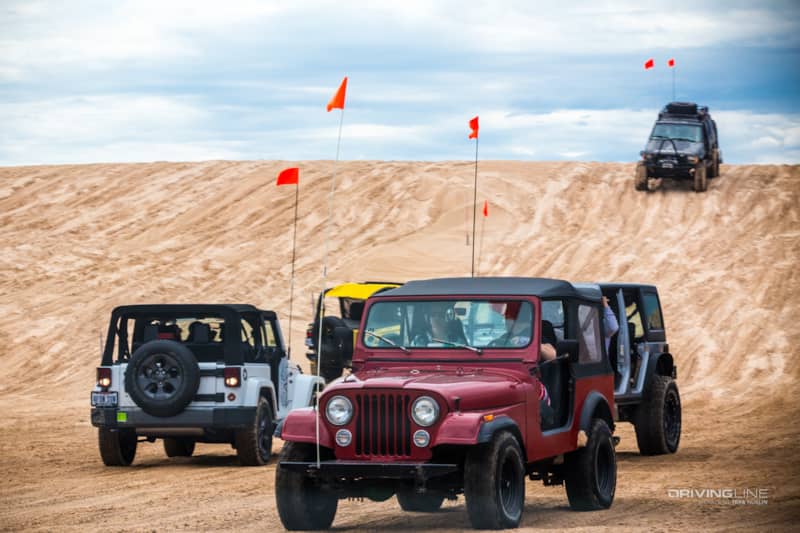
And this may sound like common sense, but when driving off-road, it is important to keep your thumbs outside of the steering wheel, especially in non-power assisted vehicles. If the wheels hit something under the sand, you will be unpleasantly surprised by a sudden, forceful jerk of the steering wheel.
Dunes are constantly moving and changing, which can result in drop-offs that weren’t there the week before. Always know what is on the other side of a dune. If unsure, walk the route to get a feel for the terrain and obstacles. It is often easier to stay inside of the ruts that other vehicles leave behind wherever possible, as this provides a clear track for your vehicle to follow. Of course, always carry recovery and safety gear, and know how to use it. Do not test your luck on sand without having another vehicle–friends don’t let friends wheel alone!
If you're new to wheeling and want some great beginner's basics, you've come to the right place. Visit Driving Line's off-roading basics page to catch up on all the info to keep you fun and safe.
Let’s get going.
Keep up your momentum, especially uphill, but not too much. Too much RPM could damage your vehicle, so you'll need to find the balance. Avoid making gear changes or rapid throttle inputs while climbing the dune. When climbing steep dunes, gain some speed, drive straight up without turning, and hold the pace until you reach the peak. If you have to back down a dune, never turn the vehicle sideways unless you want to turn your rig into a booming metal tumbleweed.
Slow down around corners and accelerate out to avoid understeer. If there is too much acceleration too early, the turn will be wider than intended. While exploring granular lands, avoid sharp corners. Turning wheels cause a lot more friction when pushing through sand compared to wheels that are pointed straight.
If you start to get stuck, straighten the wheels out to get rolling, and try again. This may require backing up and re-filling the trenches you made. Did I mention that you should have a shovel in your recovery gear kit?
All downhill from here.
Descending down steep dunes can be daunting. Before heading down, select 4WD-low (and second gear if driving a manual). In less steep or rutted declines, first gear may be acceptable, but it is typically too low of a gear; sand that travels faster than the vehicle can cause loss of control. Avoid applying too much brake if possible, because it can add traction against the sand, worsening the slide.
Some new vehicles with traction control will cause the vehicle to apply brakes to slipping wheels, which in turn can jerk the vehicle from side-to-side. If this happens, try applying a little throttle to end the vicious cycle.
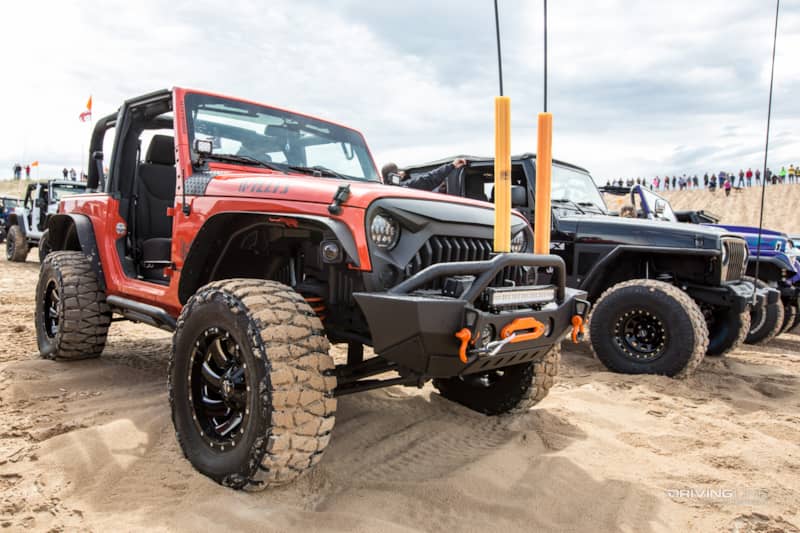
Get a grip.
If you lose traction while trekking across sand, steer from side-to side using small, rapid movements while applying the gas to gain more traction. If you completely lose forward motion, don’t continue to dig until you’re halfway to the center of the earth. Stop immediately, back out gingerly, switch into a low gear, and try again. Or, if the spinning continues, use traction mats to climb out. If you don’t have traction mats, get creative: floor mats or some strategically laid branches may do the trick. On the rare chance that the sandy patch is short and there's a body of water nearby, wetting down the path will make the sand grains sticky, helping the tires to crawl over instead of digging deeper. If all else fails, you may have to find someone to pull you out.
Learn more about navigating technical terrain.
Leave behind nothing but your tracks.
Many dune areas have been closed to motor vehicles for preservation. Take your trash with you and abide by the location’s regulations. Be respectful to nature so the terrain and trails will remain accessible for many years to come. (That's just basic off-roading etiquette.)







